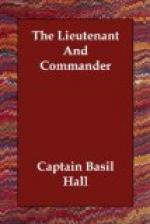The velocity with which the air drawn from beyond the tropics travels along the sea towards the equator is probably not above twenty miles an hour, a rate slow enough to allow time for the constantly-increasing friction of the earth’s rotation to act upon it, and draw it more and more entirely to the east. By the time it has reached the equatorial regions, the friction of the earth’s surface has operated long enough to carry the air completely along with it; and, of course, all relative motion being done away with, everything easterly in the character of the Trade-winds will be at an end.
But, although this constantly-increasing friction of the earth’s rotation has thus annihilated all relative easterly motion between the air and earth, that air still retains its motion towards the equator; and accordingly we do find the Trade-winds, at their equatorial limits, blowing, not from the east, as Hadley, Dr. Young, and others, conceived, but directly from the north and from the south respectively. The strength and velocity of the Trades at these places is, in general, considerably diminished, chiefly, perhaps, by the air becoming heated, and rising up rather than flowing along; and also, no doubt, by the meeting of the two opposite currents of air—one from the north, the other from the south—which produces the intermediate space called the Calms, or the Variables.
In strict conformity with these theoretical views, the clouds above the Trades are almost invariably observed to proceed in the contrary direction to the winds below. On the top of the Peak of Teneriffe I found a gentle breeze blowing from the south-westward, directly opposite to the course of the Trade-wind.
The more detailed circumstances usually met with in that part of a voyage to India which lies between 30 deg. north and 30 deg. south, and which I am about to describe, will now, I imagine, be readily understood. Before setting out, however, I must strongly recommend any one wishing to see these matters clearly, to have them fixed in his mind to useful purpose, to follow both the theoretical and the practical parts of this explanation with the assistance of a terrestrial globe.
Most ships touch at Madeira, either to take in a stock of wine, to get fruit and vegetables, or to form a pleasant break in the early and most disagreeable part of the voyage. Some ships pass barely in sight of the high mountain which rises above the town of Funchal, and satisfy themselves with taking sights for verifying the rates of their chronometers when on the meridian of the island; while others tantalise their passengers still more by sweeping through the roads, without anchoring, or communicating with the shore. The captains by such ships are pretty deeply, if not very loudly, abused by all hands, passengers especially, who are perhaps the most dissatisfied, because the most idle, of mortals. Shortly after leaving Madeira, which is in 32-1/2 deg. north latitude,




